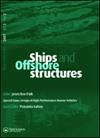新型钛合金焊接结构疲劳裂纹生长率的预测方法
IF 1.8
4区 工程技术
Q2 ENGINEERING, MARINE
引用次数: 0
摘要
为预测深海潜水器中使用的钛合金焊接结构的疲劳寿命,建立了一个考虑焊接特性和载荷序列效应的修正模型。本文章由计算机程序翻译,如有差异,请以英文原文为准。
A prediction method for new titanium alloy welded structure fatigue crack growth rate
For the fatigue life prediction of titanium alloy welded structures used in deep-sea submersibles, a modified model considering the welding characteristics and the load sequence effect is establish...
求助全文
通过发布文献求助,成功后即可免费获取论文全文。
去求助
来源期刊

Ships and Offshore Structures
ENGINEERING, MARINE-
CiteScore
4.50
自引率
14.30%
发文量
164
审稿时长
7.5 months
期刊介绍:
Ships and Offshore Structures is an international, peer-reviewed journal which provides an authoritative forum for publication and discussion of recent advances and future trends in all aspects of technology across the maritime industry.
The Journal covers the entire range of issues and technologies related to both ships (including merchant ships, war ships, polar ships etc.) and offshore structures (floating and fixed offshore platforms, offshore infrastructures, underwater vehicles etc.) with a strong emphasis on practical design, construction and operation.
Papers of interest to Ships and Offshore Structures will thus be broad-ranging, and will include contributions concerned with principles, theoretical/numerical modelling, model/prototype testing, applications, case studies and operational records, which may take advantage of computer-aided methodologies, and information and digital technologies. Whilst existing journals deal with technologies as related to specific topics, Ships and Offshore Structures provides a systematic approach to individual technologies, to more efficiently and accurately characterize the functioning of entire systems.
The Journal is intended to bridge the gap between theoretical developments and practical applications for the benefit of academic researchers and practising engineers, as well as those working in related governmental, public policy and regulatory bodies.
 求助内容:
求助内容: 应助结果提醒方式:
应助结果提醒方式:


